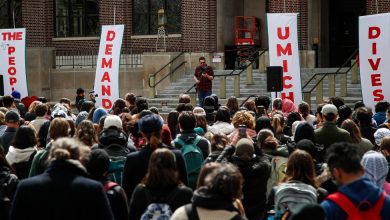
Looking for an Edge, and Some Fun, Bettors Favor Super Bowl Props
Rufus Peabody plans to bet more than $1 million dollars on this weekend’s Super Bowl, but he won’t be wagering on who will win the game.
“That’s essentially a coin flip,” he explained.
Peabody is an economics graduate of Yale University who used to work as a consultant to casino sportsbooks, helping them set betting lines. Now, he is a professional gambler who will be betting his considerable bankroll on props.
Props are bets on essentially any outcome in a game besides the victor or the points total. They can include anything from whether there will be a missed extra-point attempt (3.5 to 1) to if an offensive lineman will score a touchdown (35 to 1).
There are props that are affected by every play of the game, and even some props that have nothing to do with the game at all, like the length of the national anthem or the color of the Gatorade poured on the winning coach. Depending on the sportsbook, prop bets can account for at least half of the betting handle on the Super Bowl, which the American Gaming Association estimates is more than $7 billion in the United States alone.
Peabody and other professionals, or sharp bettors, prefer props because they’re able to find good value given the vast menu of offerings. The public, or square bettors, bet props as a way to potentially win a lot of money on a minor outlay.
“They want to be rooting for something pretty specific with a lottery payout,” Peabody said.
Peabody and some sharp bettors stay away from betting the winner or the total score, turning instead to props because they provide a better edge: There is so much money bet on who will win and what the score will be that bookmakers are able to adjust the lines very close to what the probabilities say.
Props, on the other hand, are myriad in number, opening the door to potential market inefficiencies. While Peabody makes his living on placing lots of bets with 2 percent edges, he doesn’t think the average fan cares that much about price. They’ll trade a small edge for a good sweat.
Dive Deeper Into Super Bowl LVII
- Inside a Kansas City Oasis: Big Charlie’s Saloon is a South Philadelphia bar with a bit of a conundrum: how to celebrate Kansas City’s Super Bowl berth without drawing the ire of locals.
- Philly’s Recent Success: Philadelphia, a proud city long accustomed to excruciating defeat for its sports teams, finds itself basking in a relatively rare period of hopeful achievement.
- Halftime Show: Rihanna, who last performed publicly at the 2018 Grammys, will return to the stage for the first halftime show under the N.F.L.’s new sponsorship deal with Apple Music.
Super Bowl prop bets have long been offered by sportsbooks, but traditionally on only a small number of outcomes, like the first team to score or the total number of field goals made. Today’s ever-expanding menu of props, however, can trace its origin to the January 1995 Super Bowl between the San Francisco 49ers and the San Diego Chargers.
After a string of lopsided Super Bowls during the early 1990s, bookmakers set the point spread between the 49ers and the Chargers at 19.5 points. (The 49ers won, 49-26, covering the spread easily.)
“I mean, that’s just unimaginable these days,” said Jay Kornegay, who was the director of the race and sports book for the Imperial Palace in Las Vegas at the time.
So he and a few of his staff, working on dry-erase boards in a hot and cramped office, decided they would try to make what was expected to be another boring Super Bowl a little bit more exciting. They came up with 150 different prop bets, more than three times what most sportsbooks were offering at the time.
“It was so popular,” Kornegay said, “that I’m pretty sure we were violating fire codes in that little sportsbook of ours.”
Before the 1995 Super Bowl, Kornegay estimates that props represented around 5 percent of the total handle his and other Nevada sportsbooks did on the game. Kornegay continued to add more props every year, and their popularity steadily grew.
Last Thursday night at the Westgate SuperBook, where Kornegay now works, they released more than 2,000 props for this year’s Super Bowl at what has become a yearly tradition for Las Vegas sports bettors, who line up to be the first to place their wagers. Kornegay expects over 70 percent of the bets the book will take for the Super Bowl this year will be on props.
The rapid expansion of regulated sports betting across the country has helped drive the popularity of props in recent years. While Nevada sportsbooks once had a virtual lock on the regulated market, today they compete with a slew of operators in 33 states and in the District of Columbia. Over 100 million Americans now have access to legal sports betting, and the American Gaming Association estimates that at least 46 million of them bet on the N.F.L. this season.
As last year’s Super Bowl kickoff grew near, the mobile sportsbook DraftKings reported it was taking 21,000 bets per minute. Mega-operators like DraftKings are able to offer as many props as Kornegay’s SuperBook Sports, if not more, and their customers have come to expect it.
“We’re never going to be able to duplicate the same size of menu or even come close to that, frankly,” said Jeffrey Benson, the sportsbook operations manager at Circa Sports, Las Vegas’s largest sportsbook. Rather than try to compete with the sheer volume of the big operators, Benson decided to compete for originality, crowdsourcing Circa’s prop menu on social media.
He asked bettors on Twitter which props they’d like to see offered and Benson and his team chose dozens of their favorite responses, including “Will Travis Kelce get more receiving yards than Jason Kelce snaps played?” and “Will any player score 8 points on one drive?”
The SuperBook’s menu evolves from year to year as well. “At this point in time, it’s very tough to come up with new propositions,” Kornegay said, “but we came up with a couple new ones.”
This year, the book will offer props on whether either team will convert a fourth down in its own territory, something unthinkable a decade ago, but now an increasingly common occurrence in the N.F.L. “The Eagles have done it like four times,” Kornegay said.
Offering an original Super Bowl prop bet is not without risk, however. Benson and Chris Bennett, Circa’s director of risk, are a two-person team when it comes to pricing these new props. They don’t worry too much about whether or not they get the price right or wrong, instead letting the market do the work while they adjust odds as the bets are placed.
“There’s nothing more disappointing to us than when we spend some time on a proposition and it doesn’t create a lot of interest,” Kornegay said. “If it doesn’t get a lot of interest, meaning a lot of bets, there’s a good chance you won’t see that one next year.”



